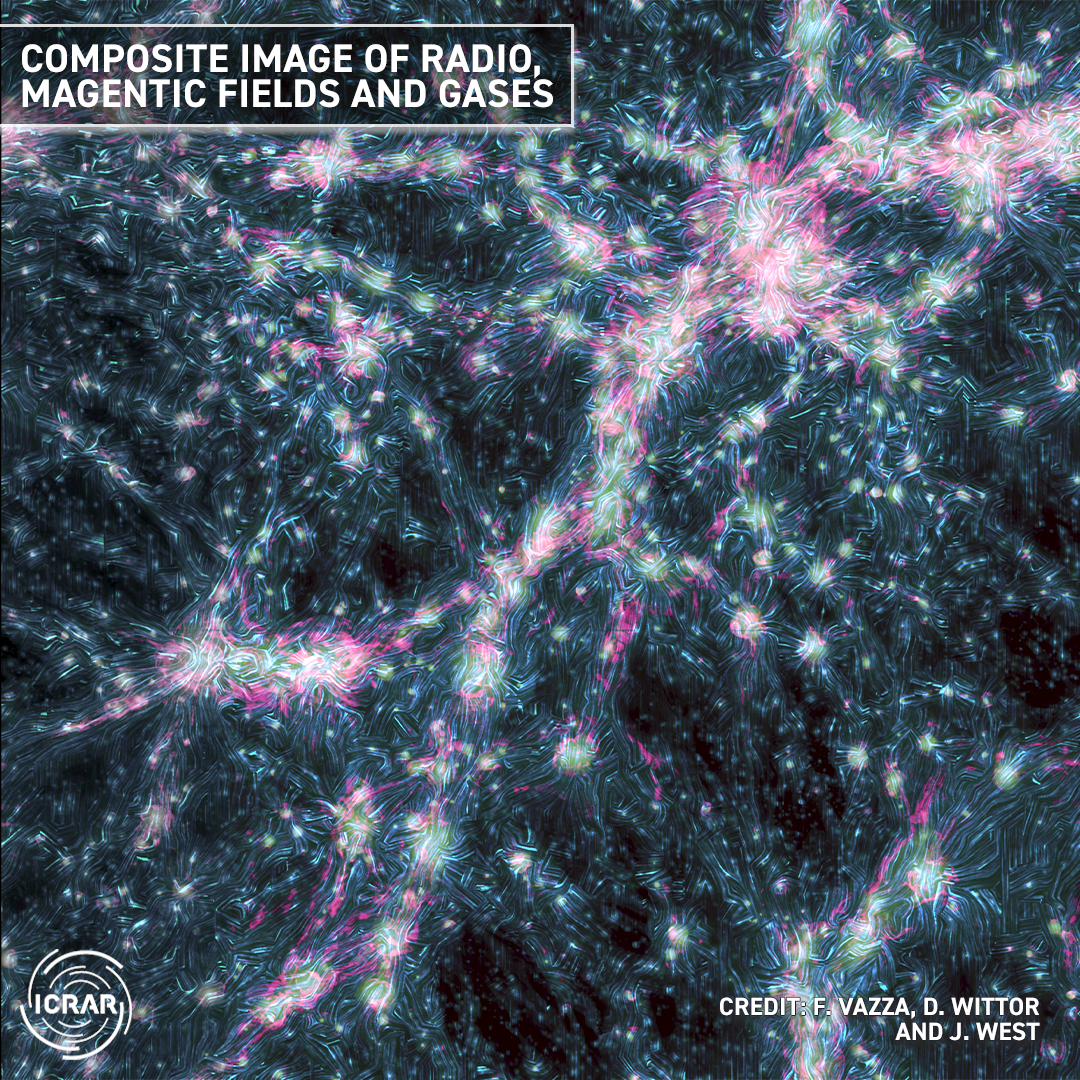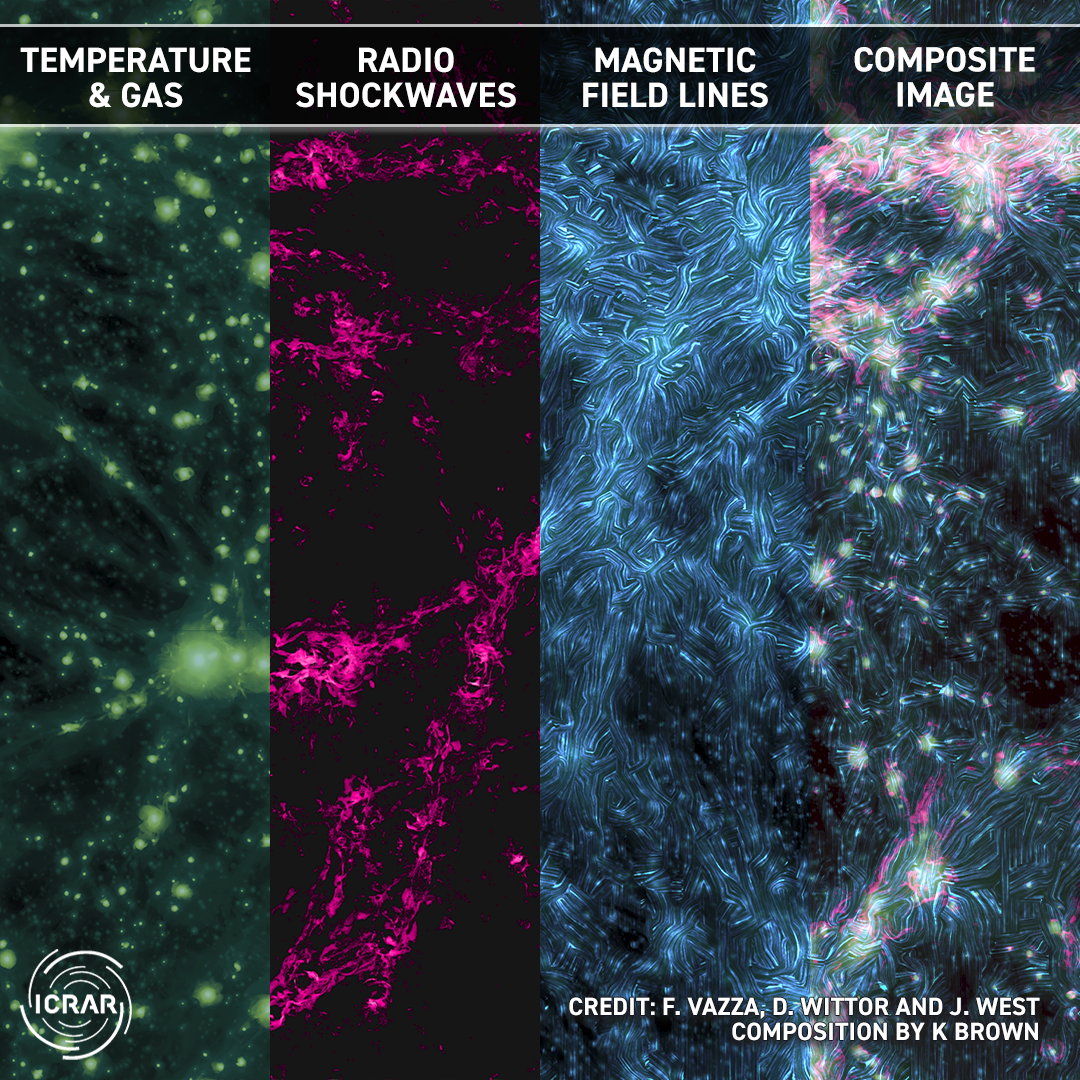Shockwaves rocking the 'cosmic web' connecting galaxies seen for the 1st time
"We are seeing emissions from the shockwaves in the largest structures in the universe."

Scientists have discovered the first evidence of shockwaves rippling through the "cosmic web," a massive network of interweaving filaments that represents the largest structure in the universe.
The discovery represents tantalizing evidence of magnetic fields weaving through the gas, dust, and dark matter tendrils which link galaxies together.
Scientists first began to think that on the largest scales, the universe is ordered in a web-like pattern with filaments that cross vast voids in space and pull galaxies into clusters in the 1960s. Two decades later using computer modeling, researchers were able to determine what this vast universal network might look like for the first time.
Astronomers have since mapped the cosmic web with actual observations in the process answering questions about its structure. One element has remained frustratingly shrouded in mystery, however: The magnetic fields that may run throughout the cosmic web.
Related: Faint Filaments of Universe-Spanning 'Cosmic Web' Finally Found
"Magnetic fields pervade the universe — from planets and stars to the largest spaces in-between galaxies," lead author and International Centre for Radio Astronomy Research (ICRAR) researcher, Tessa Vernstrom said in a statement. "However, many aspects of cosmic magnetism are not yet fully understood, especially at the scales seen in the cosmic web."
Vernstrom added that when matter merges in the universe, it produces a shockwave that accelerates particles, and this amplifies intergalactic magnetic fields. In the cosmic web, gravity draws filaments together and this should generate shockwaves that make the magnetic field in the web stronger. As a result, these fields should emit a radio wave glow that should be observable with radio telescopes here on Earth.
Get the Space.com Newsletter
Breaking space news, the latest updates on rocket launches, skywatching events and more!
"These shockwaves give off radio emissions which should result in the cosmic web 'glowing' in the radio spectrum, but it had never really been conclusively detected due to how faint the signals are," Vernstrom continued.
By stacking data and all-sky radio maps from the Global Magneto-Ionic Medium Survey, the Planck Legacy Archive, the Owens Valley Long Wavelength Array and the Murchison Widefield Array over the known clusters and filaments in the cosmic web, Vernstrom and the team spotted these radio emissions for the first time.

Strumming the filaments of a cosmic web
The researchers first started searching for signals and a radio glow from the cosmic web in 2020. They discovered initial signals from cosmic web shockwaves but couldn't rule out that these contained emissions from galaxies and celestial objects other than the shockwaves — otherwise valuable observations that were considered "background noise" in this search.
This led them to search for a different signal type, polarized radio light, which they reasoned would be blighted by less background noise. Polarization occurs when light waves pass through a filter that only allows waves with a specific orientation to emerge. After this filtering, the light has been polarized.
"As very few sources emit polarized radio light, our search was less prone to contamination and we have been able to provide much stronger evidence that we are seeing emissions from the shockwaves in the largest structures in the universe, which helps to confirm our models for the growth of this large-scale structure," Vernstrom explained.
By stacking their data, the team ensured the faint radio wave signal was strengthened. This could then be compared to state-of-the-art cosmological simulations created with the hydrodynamic astrophysical calculations of the Enzo Project. This resulted in the creation of the first simulation of the cosmic web to include predictions of the polarized radio light from the cosmic shockwaves.
Understanding the magnetic fields lit up in radio waves by these shockwaves could now be used to expand and refine our theories on how the universe expands. The results also have the potential to assist astronomers to solve the mysterious origins of cosmic magnetism.
The team's research was published in the Feb. 15 edition of the journal Science Advances.
Follow us on Twitter @Spacedotcom or on Facebook.
Join our Space Forums to keep talking space on the latest missions, night sky and more! And if you have a news tip, correction or comment, let us know at: community@space.com.

Robert Lea is a science journalist in the U.K. whose articles have been published in Physics World, New Scientist, Astronomy Magazine, All About Space, Newsweek and ZME Science. He also writes about science communication for Elsevier and the European Journal of Physics. Rob holds a bachelor of science degree in physics and astronomy from the U.K.’s Open University. Follow him on Twitter @sciencef1rst.
-
Cigarshaped Unfortunately this article reinforces the mechanistic mindset of astrophysics we have grown to expect. Shockwaves, ripples, gravity and Big Bang used to explain the Cosmic Web. What is actually being detected?Reply
There is a massive network of filaments connecting all galaxies which is emitting radiowaves and has magnetic fields threaded through it. I wonder why the word plasma is not mentioned here? Plasma is known very well to form into filaments, emit radio radiation and once conducting electricity it exhibits magnetic fields.
So the Cosmic Web could be a massive plasma filament network conducting electricity. Why the heck do we need "dark matter" to get involved??









